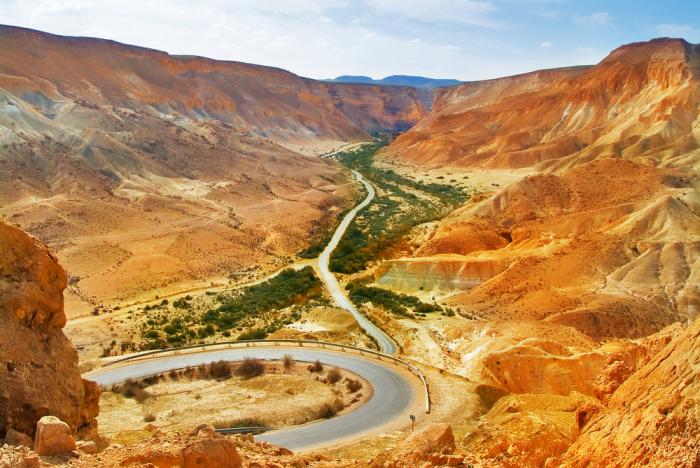- Home
- Play & Learn Home
- Online Enrichment
- Experience Modern Israel
- Israel It's Complicated
- Jewish and Me
- Jewish Holidays Jewish Values
- Jewish Values in Genesis and Jewish Values in Exodus
- Min Ha’aretz
- Our Place in the Universe
- Simply Seder
- The Prophets: Speaking Out for Justice
- Making T'filah Meaningful
- Make, Create, Celebrate
- Yom Haatzmaut Resources
- Hebrew Apps
- About The OLC
- What is the OLC?
- Introduction
- Get Started
- Resources
- OLC Content
- Parent Materials
- See My OLC Classes
- Store
Hiking the Israeli Trail
Camels stink, but when they're carrying your tent, sleeping bag, food, and water supply over miles of scorching Negev sand, you ignore your nose and follow those sure-footed dromedaries and your Bedouin guide. "Everything looked the same-sand, sand, and more sand," says 17-year-old Rina Schifsmiller from Ra'anana, who joined Jerusalem teen Nomi Cooper-Rosenberg, also 17, and seven others on Derech Hateva, a month-long hiking program along Israel's national trail. "We'd get up at 5:00 or 6:00 every morning," says Nomi, "and hike ten to 12 miles a day, depending on the terrain. "The northern and southern halves of the trail are radically different," explains Eran Gal-Or, one of Israel's foremost experts on Shvil Yisrael, the national trail. "The north is very green, with plants, trees, and natural springs, while the south is barren, with very little vegetation."
Derech Hateva teens spend three weeks hiking in the north, and then are driven by bus to the south. "In the north, we had to be responsible, paying attention to maps, to the sun, remembering where we were, watching for trail markers," Rina recalls. "But in the Negev, we had no idea where we were. We relied on our guide. The South was just otherworldly; it really put you in a different place mentally."
By the time the group arrived in the barren Negev desert, which is speckled with rugged granite mountains and red and green boulders, the hikers were also in a very different place physically. "Going without a shower, or without washing my hair for three weeks might have been the hardest part of the trip," Nomi laughs. "I still can't believe I did that." The absence of other luxuries, such as beds and toilets, added to everyone's physical discomfort.
Thankfully, Shabbat is a day of rest, even in the wilderness. Organizers plan the program so that each hike on Friday is short. When the group arrives at its Shabbat campsite, they divide into three groups: one group cooks, usually pita bread baked on a little flame, and some vegetables; one group digs toilets; and one group erects an eru, a boundary marker that sets aside a specific area, within which religiously observant Jews are allowed to carry on Shabbat. "The counselors carried a little Shabbat kit that had a few extra candles on a string, so we had a little light, but not enough to read by," says Rina. "We davened (prayed), but it was so dark, it was mostly what we could remember by heart. Then we slept under the stars." While gazing into a limitless evening sky that sparkled with light from billions of distant worlds, Rina and Nomi marveled at God's creative power, a divine quality they had praised during Kiddush.
"I didn't realize how much this experience would change my perspective," Rina says. "While you're on the trail, you're a different person. At home, there are so many things you think you need. But on the trail, we had only the bare necessities. Spending a month walking the land helped me find out who I really am inside."
Israel Trail by the Numbers:
- 1947 and 1995--the years when marking the Israel Trail began and was completed, respectively
- 528--miles long, from Tel Dan in the north to Eilat in the south
- 12--segments that make the trail accessible to those who want to hike only small portions
-100,000--people who hike segments of the trail each year
- 300--fit hikers who walk the entire trail (called thru-hike) each year, a feat that takes about 30 days
- 3--colors blaze the trail: orange, blue, and white, so it's difficult to get lost
- 1:50,000--the scale on maps of the Israel Trail, where one centimeter (.39 inches) on the map represents two kilometers (1.2 miles) on the ground Tips for Hikers:
- Wear sturdy shoes to give your feet good support.
- Use a cell phone to stay in touch with someone who's not on the hike, so someone will know where you are every day.
- Other than that? "Come to Israel and hike!" says Eran. "You should know your own country as well as you know your own home. My Israeli peers go to India or South America to do much the same thing as I do here. I wanted to know Israel first. It's an incredibly beautiful place."
0
Play the music video of "Kum VeHithalech BaAretz".


